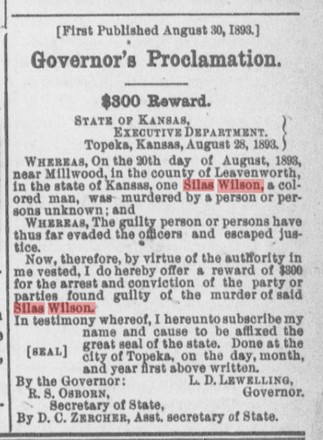Silas J Wilson
Introduction
Text-to-speech Audio
Images
Honey Locust Tree

Newspaper Clip of Reward

Backstory and Context
Text-to-speech Audio
On a Monday evening, Mr. Wilson started getting negative backlash within the town when he started becoming friends with a 16-year-old girl at Round Prarie. Even though he never did anything criminal the men of the town believed it to be rape with no proof. These men were not fond of his supposed actions and threaten to drive him out of town. Later that week on a Sunday afternoon Mr. Wilson was visiting the Eight Mile House where he and Henry Ehart got into an altercation that resulted in Ehart striking him. The next time Silas Wilson was spotted was later that night hanging by a tree.
He was spotted by two young men returning home from Millwood where they detected his body hanging from a honey locust tree near the roadside. They were soon able to identify the body as a “colored man” and took it to Dr. A. G. Chase to be examined. Dr. A.G. Chase states that “ He was hung with a long halter or lariat rope, 25-30 feet long, his arms tied behind him and one sleeve of his coat partly off “. This act was thought of to be done in the dark by four or five men in a spring wagon. There was visual evidence that Mr. Wilson’s body was dragged with a rope around his neck for a hundred yards or more. Also present was a severe contusion wound to his head that was created from a club. They hung the body on the high bank overlooking Witt’s crossing about 300 yards south of the bridge.
An investigation lead by Coroner Hamilton was soon started over the suspected lynching of Silas Wilson. Evidence was hard to come by so a Governor’s Proclamation was published in the state of Kansas. This created a $300 reward for the arrest or conviction of the party or parties found guilty of the murder of Mr. Wilson. After a long-drawn wait, there was no more additional evidence found and the court ruled a verdict of death by hanging, by persons unknown by the jury.
Sources
Sources:
Humanities, National Endowment for the. 1893. “The Advocate and Topeka Tribune. [Volume] (Topeka, Kan.) 1892-1894, September 20, 1893, Image 11.” Chroniclingamerica.loc.gov, September 20, 1893. https://chroniclingamerica.loc.gov/lccn/sn85031982/1893-09-20/ed-1/seq-11/#date1=1777&sort=relevance&rows=20&words=Silas+Wilson&searchType=basic&sequence=0&index=7&state=&date2=1921&proxtext=Silas+Wilson&y=0&x=0&dateFilterType=yearRange&page=1.
“May 1933, Kansas Historical Quarterly.” n.d. Www.kancoll.org. Accessed April 22, 2021. http://www.kancoll.org/khq/1933/33_2_cover.htm.
The Leavenworth Times. 1893. “Wilson3,” August 22, 1893. https://www.newspapers.com/clip/8864528/wilson3/.
Studio, A. (n.d.). Bibliography. Retrieved April 22, 2021, from https://plaintalkhistory.com/monroeandflorencework/evaluate/bibliography.html#id1]
